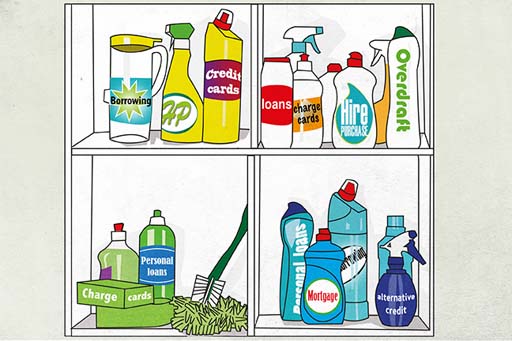4.3.1 Borrowing can take many forms
Here’s a run-down of the most common forms of borrowing.
Overdrafts: a flexible means of accessing debt on a bank current account, up to a limit approved by the lender. Unapproved overdrafts normally attract penalty fees and high interest charges.
Credit cards (including store cards): their credit limits are set by the lender and normally require a minimum amount to be repaid each month – typically between 2% and 5% of the balance of debt. They may offer a short period of interest-free credit until payment is due. Credit cards vary widely in the interest rate charged on the balance that is not paid off, and some have an annual fee attached, although many do not. Store cards are a form of credit card used for buying from specified outlets. They tend to have much higher interest rates than credit cards.
Charge cards: can be used like credit cards to make purchases and obtain approximately two months’ free credit between purchase and paying off the outstanding amount. Charge cards differ from a credit card in that a borrower is required to pay off the entire balance each month. The two-month free credit period arises when the charge card bill is sent out monthly, with a further month in which to settle the bill. A fee may be payable for the card.
Personal loans: loans made to individuals, typically with terms of between one and ten years. They may be either unsecured or secured against a property (such as a house) or other assets. Unsecured personal loans are not contractually linked to any assets the borrower buys. These are available from credit unions, banks, building societies, direct lenders and finance companies.
Hire purchase (HP): a form of secured debt where payments (interest and part repayment of the principal) are made over a period, normally of up to ten years, to purchase specific goods. The legal ownership of the product only passes to the borrower when the final instalment has been paid.
Mortgages: loans to purchase property or land, which are secured against these assets. Debt terms for mortgages are normally up to 25 years. There are many types of mortgage and it’s possible to fund spending through equity withdrawal. Since the financial crisis, however, lenders have become more cautious about equity withdrawal, particularly in the wake of the decline in average house prices after 2007. We look at mortgages in more detail in Week 6.
Alternative credit: these are the areas of sub-prime lending described earlier, and include buying on instalments through mail-order catalogues, doorstep lending and ‘payday lending’. Commonly, interest rates are high and there are heavy penalties for late payment.
Peer-to-Peer (Peer2Peer) lending: this is an emergent form of lending in the UK and involves savers pooling funds for on-lending to individuals and businesses. This form of lending, arranged through intermediaries like Zopa and Financial Circle, circumvents banks and other conventional lenders.

